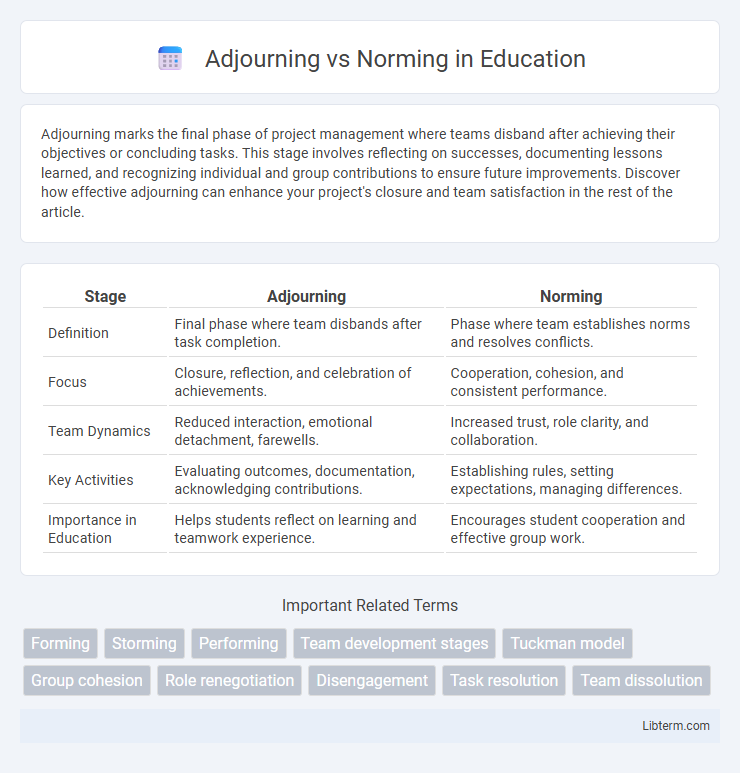Adjourning marks the final phase of project management where teams disband after achieving their objectives or concluding tasks. This stage involves reflecting on successes, documenting lessons learned, and recognizing individual and group contributions to ensure future improvements. Discover how effective adjourning can enhance your project's closure and team satisfaction in the rest of the article.
Table of Comparison
| Stage | Adjourning | Norming |
|---|---|---|
| Definition | Final phase where team disbands after task completion. | Phase where team establishes norms and resolves conflicts. |
| Focus | Closure, reflection, and celebration of achievements. | Cooperation, cohesion, and consistent performance. |
| Team Dynamics | Reduced interaction, emotional detachment, farewells. | Increased trust, role clarity, and collaboration. |
| Key Activities | Evaluating outcomes, documentation, acknowledging contributions. | Establishing rules, setting expectations, managing differences. |
| Importance in Education | Helps students reflect on learning and teamwork experience. | Encourages student cooperation and effective group work. |
Understanding Team Development Stages
Adjourning and Norming represent critical phases in the Tuckman model of team development. Norming involves establishing group cohesion, shared norms, and effective collaboration, while Adjourning marks the conclusion of a project or team, focusing on disbandment and reflection. Understanding these stages helps optimize team productivity by fostering stability during Norming and ensuring smooth project closure during Adjourning.
Defining the Norming Stage
The Norming stage in team development is characterized by the establishment of group cohesion, shared expectations, and collaborative problem-solving. Team members develop clear roles, strengthen relationships, and align their goals, enhancing productivity and trust. This phase sets the foundation for effective teamwork before progressing to the Adjourning stage, where project completion and team disbandment occur.
Characteristics of Adjourning
Adjourning is the final stage of team development characterized by the dissolution of the group after achieving its goals, with members experiencing a sense of closure and reflection on accomplishments. Emotional responses such as sadness, relief, or nostalgia are common as individuals prepare to move on to new projects or teams. Documentation of lessons learned and celebration of successes often occur during this phase to solidify team cohesion and acknowledge contributions.
Key Differences: Norming vs Adjourning
Norming represents the stage in group development where members establish cohesion, agree on roles, and develop shared norms to enhance collaboration and productivity. Adjourning occurs later as the group disbands after achieving its goals, focusing on reflection, evaluation, and the emotional process of separation. Key differences between norming and adjourning include the group's focus on building stability and cooperation during norming, versus closure and dissolution during adjourning.
Team Dynamics During Norming
In the Norming stage of team dynamics, members establish cohesion by resolving conflicts and agreeing on shared goals, which enhances collaboration and trust. Clear communication patterns emerge as roles and responsibilities are defined, promoting consistent performance and mutual support. This phase solidifies the foundation necessary for productive teamwork before progressing to the Adjourning stage, where project closure and member separation occur.
Emotional Impact of Adjourning
Adjourning phase often brings a mix of relief and sadness as team members conclude their collaborative efforts and prepare to separate. Emotional responses like nostalgia, loss, and anxiety about future uncertainty are common, reflecting the deep interpersonal bonds formed during previous stages such as norming. Managing these emotions effectively can enhance closure and support positive transitions for individuals and the team as a whole.
Leadership Strategies in Each Stage
Effective leadership during the Norming stage emphasizes fostering collaboration, reinforcing team cohesion, and encouraging open communication to solidify group norms and shared goals. In the Adjourning stage, leadership strategies shift toward recognizing achievements, facilitating smooth transitions, and providing support for team members' future endeavors. Tailoring leadership approaches to each stage enhances team stability and successful project closure.
Challenges Faced in Norming and Adjourning
Norming challenges include overcoming lingering conflicts and building trust to ensure cohesive team collaboration, while maintaining consistent communication and aligning individual goals with group objectives is crucial. In the Adjourning stage, teams face difficulties such as managing emotional responses to disbanding, preserving knowledge transfer, and ensuring smooth transitions without losing momentum. Both stages require strong leadership to address uncertainty and facilitate positive closure while sustaining team performance.
Best Practices for Transitioning Between Stages
Effective transitioning between the Norming and Adjourning stages involves clear communication of goals and achievements to reinforce team cohesion while preparing members for closure. Facilitating reflective discussions and celebrating successes enhances group satisfaction and supports emotional processing during disbandment. Implementing structured feedback sessions and future networking opportunities maintains relationships and encourages ongoing collaboration beyond the project lifecycle.
Conclusion: Leveraging Both Stages for Team Success
Adjourning and Norming are critical stages in Tuckman's team development model that serve distinct yet complementary purposes for team success. Norming fosters cohesion and establishes shared norms, enhancing collaboration and productivity, while Adjourning provides closure and recognition of achievements, promoting positive transitions and team morale. Leveraging both stages effectively ensures sustained team performance and prepares members for future challenges and opportunities.
Adjourning Infographic

 libterm.com
libterm.com